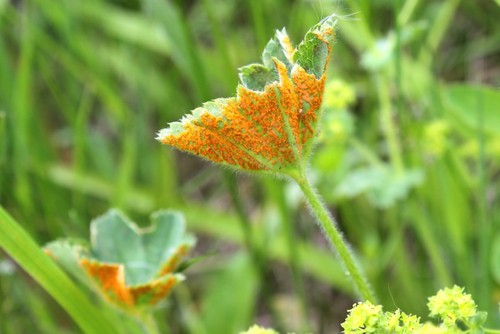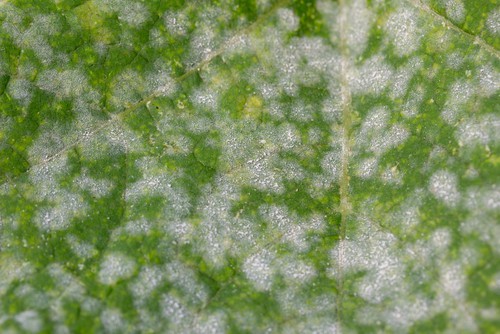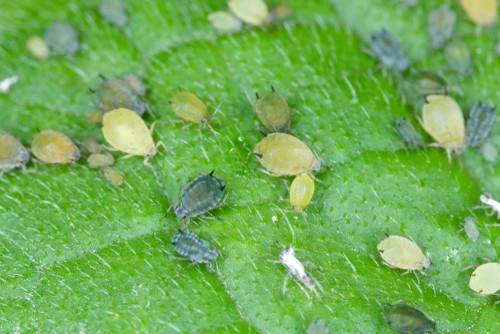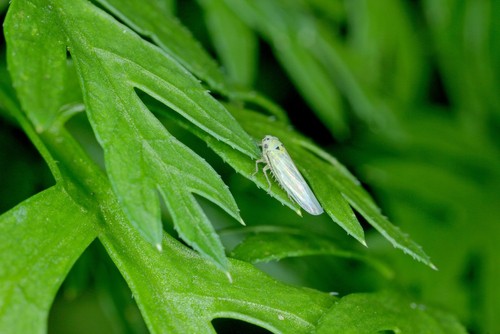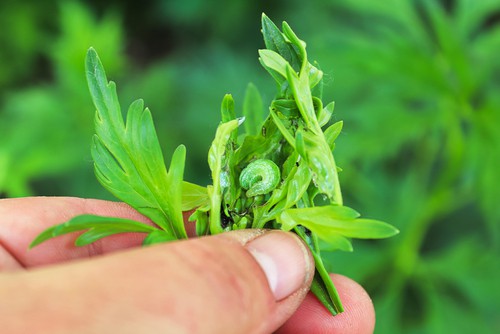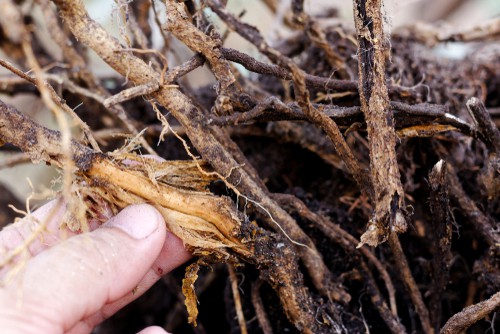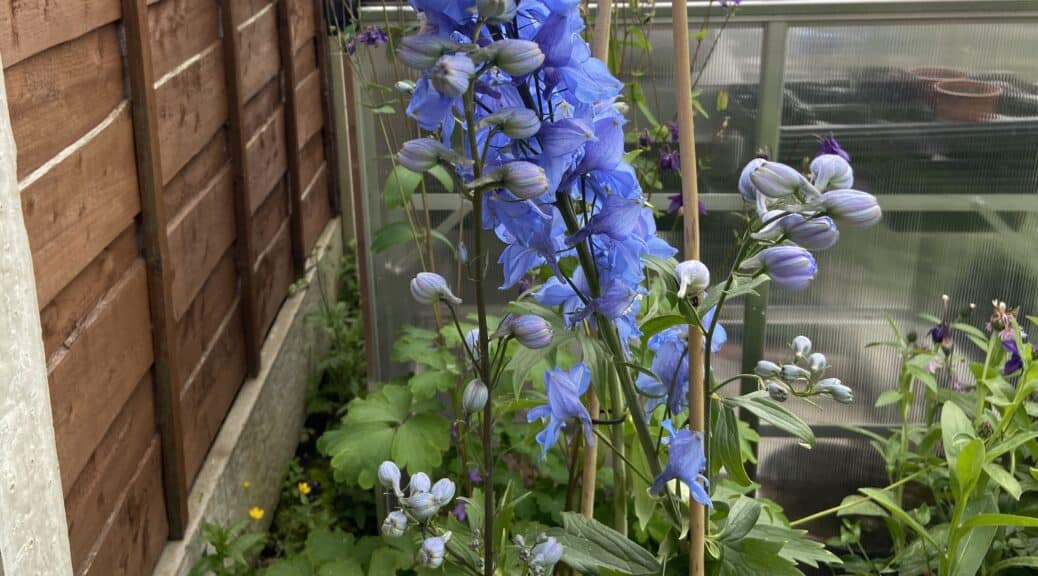
Problems with delphiniums – pests and diseases
Our site is reader supported, this means we may earn a small commission from Amazon and other affiliates when you buy through links on our site.
Delphinium problems include several fungal diseases, bacterial problems, viruses, and infestations of pests and other bugs. Unfortunately, once infected, many of these plants can’t be saved.
Personally, I have found that the most common problems are probably slugs and snails in spring that will demolish fresh growth. I usually use slug traps but you can also use organic slug pellets. I have also had issues with powdery mildew. Usually, I spray with a fungicide as soon as I notice mildew and also try to keep the soil around the base moist as it seems to be worst in dry weather.
Rust has also been a problem so I remove affected leaves and spray the leaves with a fungicide. It’s worth noting the same fungicides will usually treat mildew and rust.
If you have an issue with your delphinium leaves turning yellow or brown, check out this article here. Another problem I’ve been asked about over the years is why delphiniums might not flowering so I also have a guide on what causes this. Don’t forget to also stake your delphiniums to stop them from falling over.
Below I go into more detail and start with the most common delphinium pests and diseases.
Powdery mildew
Powdery mildew is another fungal disease that occurs on the top of the delphinium leaves in humid and dry summers.
What to look for – powdery mildew
The delphinium leaves may be curled and have a whitish or grey surface. If left unchecked, powdery mildew causes the leaves to eventually turn yellow and die from the base of the stem upward.
What to do
The spread of powdery mildew can be checked if you ensure that there’s always good air calculation throughout and within your delphiniums. Space them apart adequately and prune them so they don’t become overgrown. Apply a fungicide when you first notice the fungus. And, at the end of the growing season when you’re cleaning up, destroy any matter from the diseased plants. In addition, keep the soil around the delphinium moist to keep powdery mildew from moving in.
Slugs and snails
You need to be out in your delphinium patch early in the spring before the slugs and snails emerge. As soon as the new shoots appear, snails and slugs consider your delphiniums to be an amazing buffet.
What to look for – slugs and snails
Snails and slugs are usually only 3cm to 6cm long. You can spot them in real-time as they’re white, grey, yellow or black, and slimy (slugs) or have shells (snails). As slugs and snails come out at night, you might need to do some after-dark exploring.
You can also spot if these gastropods have already been at your delphiniums by the large ragged holes in the leaves and stems. Pay particular attention for these creatures if your garden is moist and well-mulched (as it should be) and also slightly acidic.
What to do
Start with some home remedies. Pour some beer into a shallow plate near the delphiniums. Wait for the slugs and snails to come along (they love the yeast in beer), walk into the plate and drown. You can also use a strong solution of garlic juice and water to around the plant to deter slugs and snails. And there are also organic slug pellets available.
Aphids
Aphids are sap-sucking insects that feed on the underside of leaves.
What to look for – aphids
Look for greenish, black, peach or red tiny specks on the undersides of the leaves. as they’re very small you may miss them but see the sticky substance they leave behind. This attracts ants, so an influx ants might lead you to the aphids.
What to do
The first step in controlling aphids is to introduce their natural predators into the environment. Try ladybirds/ladybugs or wasps who feed on aphids. Or try washing off the aphids with a strong spray of water. Or try using an insecticidal soap.
Cyclamen Mites
These mites also damage plants by sucking the juice from the leaves and stems. They multiply rapidly in hot weather so it’s best to check for them at those times.
What to look for – Cyclamen Mites
Cyclamen mites are so tiny you need a magnifying glass to see them. You could examine your delphinium with one. Or, instead, see if your plants look stunted or deformed and are not flowering. If there are flowers, they will be distorted, with streaks of colour and blotches. Not at all attractive.
The leaves also give clues as to the presence of cyclamen mites. The leaves are also deformed – curled, thickened, smaller than usual or in a cup shape.
What to do
If your plant is severely infested, you need to get rid of it at once. For lighter infestations of these mites, use an insecticide. And keep the plant adequately watered in the summer, especially in dry periods.
Leafhoppers
I mention leafhoppers in their own right (as well as the cause of the aster yellow disease). Even if they don’t bring disease, they disfigure the leaves, stems and blooms.
What to look for – leafhoppers
Look for plants whose growth is stunted. Also check if the leaves look the wrong size, shape or colour.
What to do
Remove the injured and affected parts of the plant. Use a strong spray of water to dislodge leafhoppers. Or try an insecticide.
Leafminers
Leafminers don’t kill your delphinium plant but they do make it quite unsightly.
What to look for – leafminers
Leafminers are insects that tunnel just under the leaf surface. You can see where they are or have been by the irregular undulating lines that they leave. You may see the larvae as they’re yellow maggots that are cylindrical in shape. Adult leafminers are small flies that are yellow and black.
What to do
Once again, remove the affected foliage, flowers and stems. Be quite ruthless and get all the infected parts. Try insecticide to get any leafminers that are left behind.
Delphinium worm
The delphinium worm is one problem with this plant that you can do something about.
What to look for – Delphinium worm
Delphinium worms spend their winter inside the hollow stalks of the plant. They emerge in spring to feed on the new growth. Examine the plant closely for these worm-like creatures. They eventually travel down the plant to the older leaves where they spin a cocoon. You can see the cocoons quite easily.
The adult worms hatch from the cocoons and then breed by laying eggs on the plants in late summer. The young worms emerge, feed on the plant and then burrow inside a hollow stem for the winter. And it all starts over again.
What to do
It’s a matter of observation and removing what you do find. Pick off any new worms that you see on the leaves in the spring time. If you notice the cocoons further down the plant in the early summer, make sure to pick each one off and crush it to kill the larva inside. And if you come across the eggs on the plant later on, brush them off or use a heavy water spray to get rid of them.
And to remove the delphinium worm’s winter habitat, cut the hollow stalks down to the ground in your pre-winter preparation.
Viruses (assorted)
Viruses that attack delphiniums include tobacco mosaic and cucumber viruses and tomato or ringspot wilt. These viruses use the plant’s metabolism to replicate and produce more of themselves.
Black blotch
Black blotch is an ugly disease that can affect all above-ground parts of delphiniums. The good news is that it’s not fatal but it does reduce the strength and health of the plant.
What to look for – black blotch
This disease occurs mostly in wet summers. Check leaf surfaces, especially upper surfaces, for irregular brown-black blotches. The blotches are sometimes shiny and may merge together. If the blotches cover a large surface area, the leaf may turn brown and die. If you find the blotches, also check the leaf stalks, flowers and stems to see if they’re also infected. Plants that become heavily infected lose strength and become stunted in growth and weak.
What to do
If your delphinium has black blotch, get rid of the plant immediately. And do not plant another delphinium on the same site. Don’t take cuttings from the infected plant not save any of the seeds.
If the problem is one just one or two leaves, remove only them. And then keep a close watch on the rest of the plant to see if further splotches develop.
There are no fungicides available for this disease.
Bacterial crown, stem and root rot
Bacterial rot arises in several parts of the delphinium plant, including the roots of seedlings.
What to look for – bacterial rot
If your plants’ growth has been stunted and the leaves are the wrong shade of yellow, they may have a bacterial infection causing rot in the crown or stem. In wet conditions, you may also small an unpleasant odour coming from the plant. The plant stems may begin to fall over, signifying their weakened state.
Look for black places at the base of the stems. These will be around cracks and wounds, and mark where the bacteria entered.
Bacterial stem rot is seen as black, irregular shaped spots on the leaves.
What to do
You need to be extreme and destroy the infected delphinium plant, whatever bacterial rot it has succumbed to. Don’t plant another delphinium in its place as the bacteria may still be in the soil.
The bacteria flourishes in wet conditions on the leaves, so avoid watering the plant from overhead.
Aster yellows
Leafhoppers spread the aster yellow disease.
What to look for – aster yellows
You may notice it when your delphinium flowers don’t appear as they should. Instead of the normal flower parts, a leaf-like tissue appears. The flower petals turn light green or green colour and become deformed. Sometimes flowers on only one side of the stem become affected.
What to do
Once again, extreme action is called for. Remove and destroy the affected plant. Use biological or chemical control methods to deal with the local leafhopper population. Insecticidal soap is a good choice to start with.
And make sure that the surrounding area is weed free. Leafhoppers also like living in weeds and can spread the disease from there.
Diaporthe blight
This fungal disease goes through several stages so you may catch it in one of several incarnations.
What to look for – Diaporthe blight
You start to notice if your plant has diaporthe blight when the plants start to produce blooms. It starts with the lower leaves becoming brown and dying. After this, brown spots appear on the stems at ground level and then move upwards, but just a few centimetres.
The next stage is when black, small, fungal pimples develop on all the plant tissue that’s infected.
What to do
There’s nothing for it but to pull out and destroy the plant. Be careful where you buy your delphinium seed from as it’s that that brings in the diaporthe blight fungus.
Fusarium wilt and canker
It’s not difficult to spot plant tissue infected with the Fusarium wilt and canker disease. Some lesions in the plant matter become very long.
What to look for – Fusarium wilt and canker
To see if your plant is infected with this disease, start by looking at the stems. Small brown spots appear there and then grow larger. Sunken wounds may appear on the bit of the stem that attaches the leaves to the stem. All these wounds may become dark brown and up to 30cm long.
As the brown infected tissue dies away, clumps of pink spores appear. And the plant starts to wilt.
What to do
You guessed it – remove and destroy the affected plants.
What to look for – viruses
Common symptoms of the presence of virus(es) in your delphinium are loss of colour; uneven colour; yellow leaves and yellow rings on leaves; stunted growth of the plant, leaves or flowers; and deformed flowers, leaves or buds.
Viruses can be carried manually between plants, even by you. So sanitise your pruners and other garden tools frequently when you’re dealing with diseased or infected plants.
What to do
Start by buying your delphinium seeds, cuttings and potted plants from a reputable source. Take control of any insect or bug infestations in your garden, and keep the ground weed free. And immediately remove and burn any plants that become diseased.
Warning
When you have to pull and destroy all or part of your delphinium plant, don’t put the affected stems, flowers or leaves on your compost pile. It’s best to dispose of them by burning them to make sure the pests and diseases are eradicated from your garden.
I also recommend reading my how to overwinter delphinium guide as this also helps reduce pests and diseases too.
